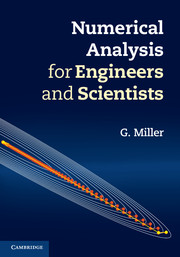Book contents
- Frontmatter
- Contents
- Preface
- 1 Numerical error
- 2 Direct solution of linear systems
- 3 Eigenvalues and eigenvectors
- 4 Iterative approaches for linear systems
- 5 Interpolation
- 6 Iterative methods and the roots of polynomials
- 7 Optimization
- 8 Data fitting
- 9 Integration
- 10 Ordinary differential equations
- 11 Introduction to stochastic ODEs
- 12 A big integrative example
- Appendix A Mathematical background
- Appendix B Sample codes
- Solutions
- References
- Index
12 - A big integrative example
Published online by Cambridge University Press: 05 June 2014
- Frontmatter
- Contents
- Preface
- 1 Numerical error
- 2 Direct solution of linear systems
- 3 Eigenvalues and eigenvectors
- 4 Iterative approaches for linear systems
- 5 Interpolation
- 6 Iterative methods and the roots of polynomials
- 7 Optimization
- 8 Data fitting
- 9 Integration
- 10 Ordinary differential equations
- 11 Introduction to stochastic ODEs
- 12 A big integrative example
- Appendix A Mathematical background
- Appendix B Sample codes
- Solutions
- References
- Index
Summary
The ab initio determination of molecular structure is an example that will use:
• singular value decomposition (Section 3.4) in particular the Lowdin decomposition (8.13) encountered in data fitting;
• the QR method for eigenvalues and eigenvectors (Section 3.3);
• interpolation (Chapter 5);
• fixed point iteration (Chapter 6) with stabilization by damping (Section 8.4);
• data fitting (Chapter 8), which involves solutions of linear systems (Chapter 2);
• integration: generally (Chapter 9), and Gaussian integration in particular (Section 9.4, Problem 9.6, which requires numerical root finding (Section 6.6) to set up), and the use of recursions, e.g., (10.35); and
• optimization with the variable metric method (Section 7.4).
In addition, concerns about numerical error (Chapter 1) are omnipresent. We will encounter the error function (Problems 5.7 and 9.7), and lots of Gaussian integrals (equations (8.10), (11.8), and (11.29)). We will use a paradigm called the variational principle that is essentially what motivated the conjugate gradient algorithm (Section 4.1).
The chemical physics problem is described in Section 12.1, and the Hartree–Fock–Roothaan equations are derived. These determine the energy of a particular molecular configuration. The HFR equations rely on a number of integrals of Gaussian functions that are introduced in their simplest form in Section 12.2. With these simple formulas we determine the energy of the H2 molecule for prescribed geometry, demonstrating in Section 12.3 reasonable results compared to far more elaborate calculations. In Section 12.4 the more complex Gaussian integrals are addressed.
- Type
- Chapter
- Information
- Numerical Analysis for Engineers and Scientists , pp. 326 - 352Publisher: Cambridge University PressPrint publication year: 2014



